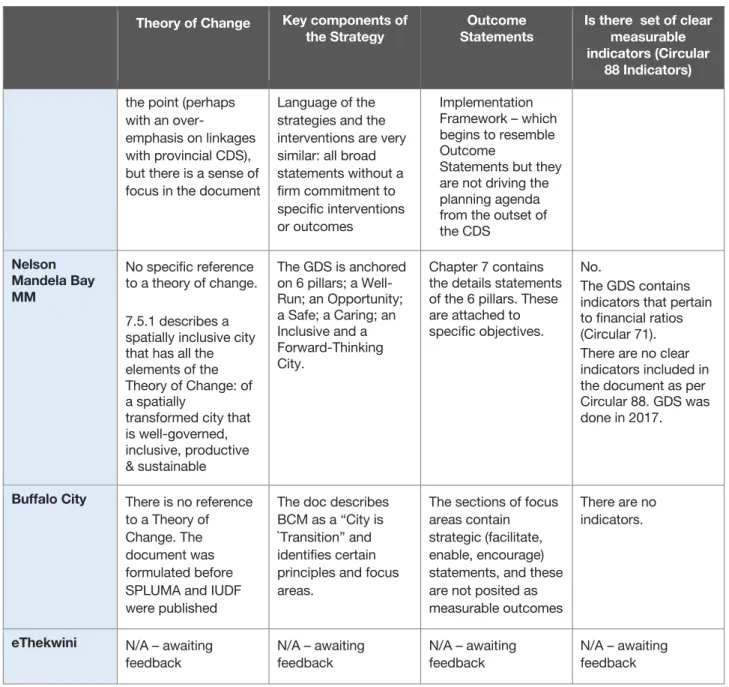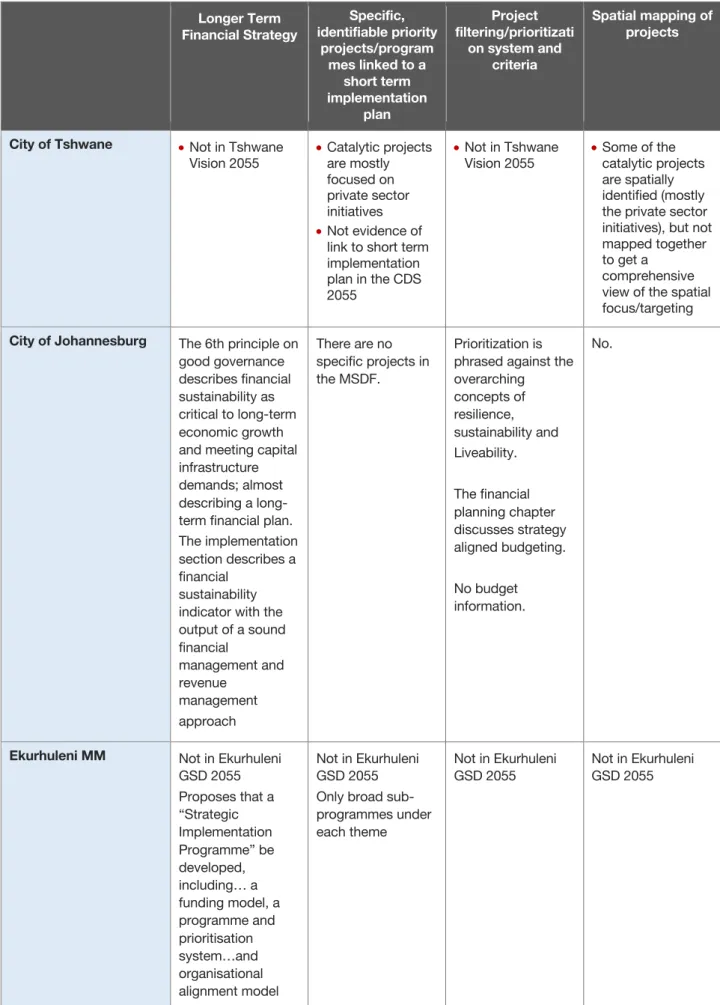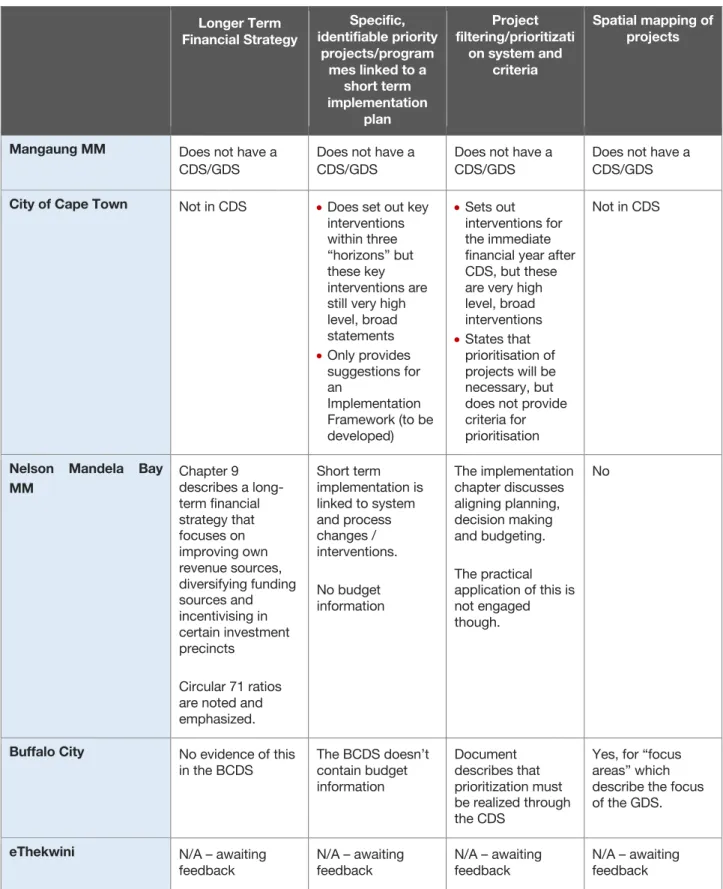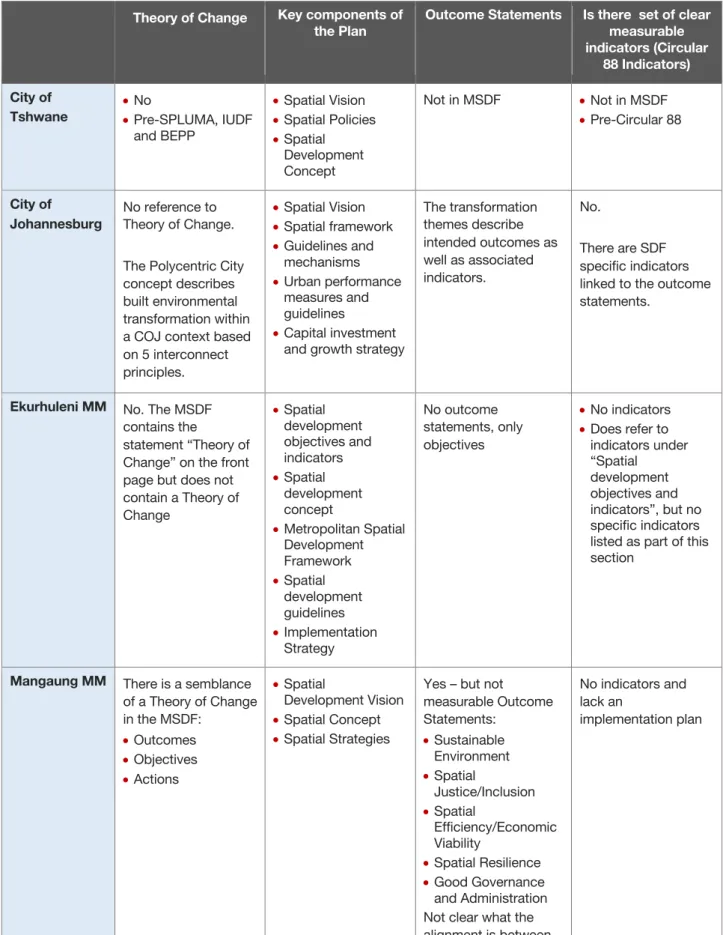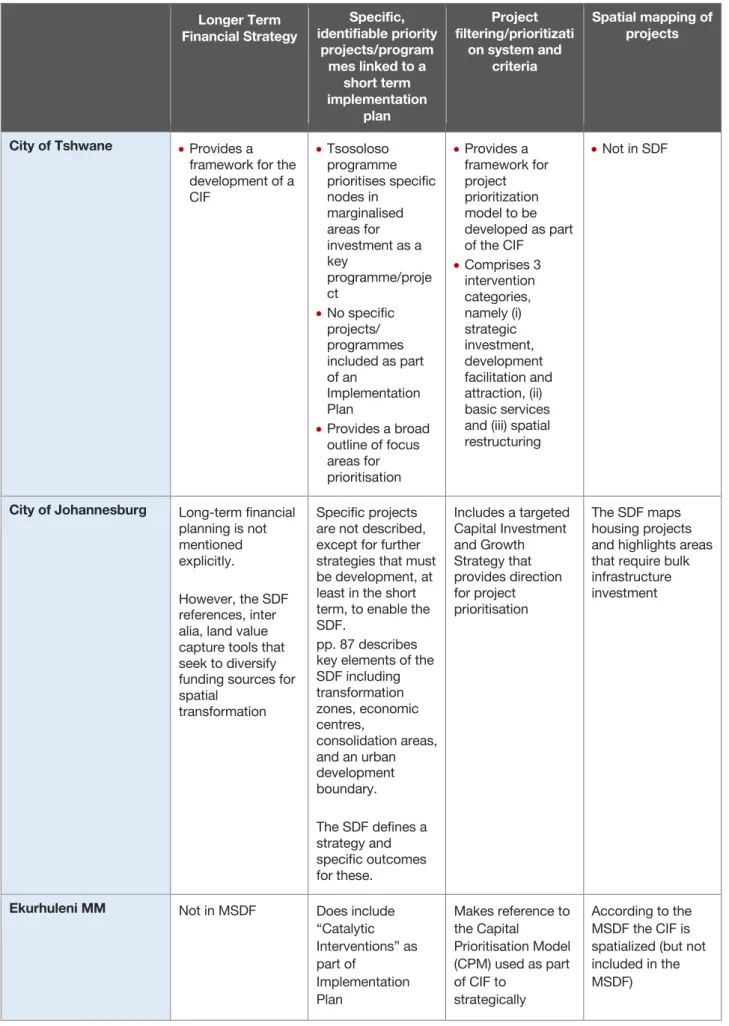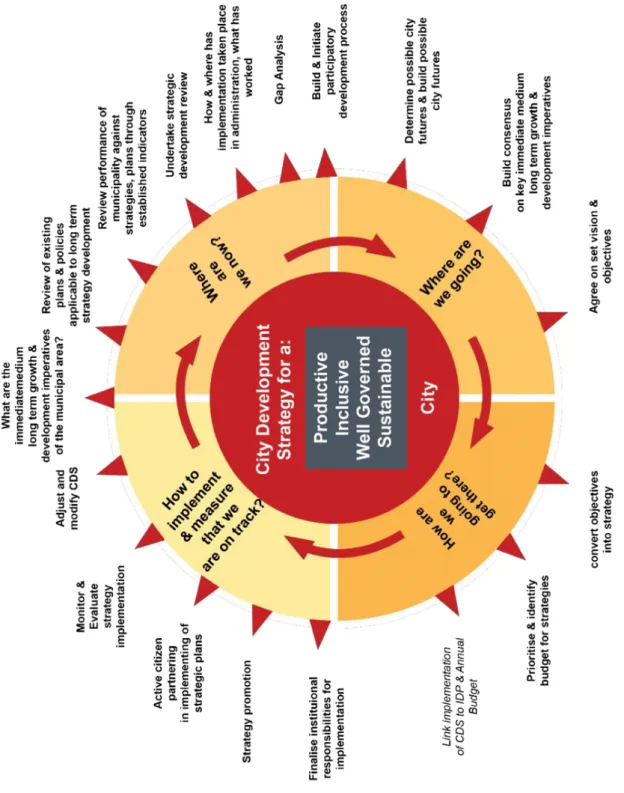The language of strategies and interventions is very similar: all general statements with no firm commitment to specific interventions or outcomes. Statements, however, do not direct the planning agenda from the outset of the CDS. A clear rationale for the spatial transformation. City network strategy. City of Johannesburg. GDS is explicit in that it is not even a.
Mangaung MM Has no CDS/GDS Has no CDS/GDS City of Cape Town • No Spatial Strategy. None of the targets driving the CDS are specific to spatial transformation - spatial aspects are implied in some targets. The urban network strategy is mentioned as one of the elements of spatial inclusivity under the 'Inclusive City' pillar.
Vision 2055 • Some of the catalyst projects have been spatially identified (usually private sector initiatives), but not mapped together to form a . Does not have CDS/GDS City of Cape Town Not in CDS • Contains key. The GDS maintains the theme of recognizing national and provincial imperatives as established, and the local government's responsibility to implement them through improving financial and project management (human and technical) Ekurhuleni MM The spatial strategies of the GDS.
Bay MM Pillar 5: Inclusive The city recognizes the role of the SDF in realizing the goals of this pillar.
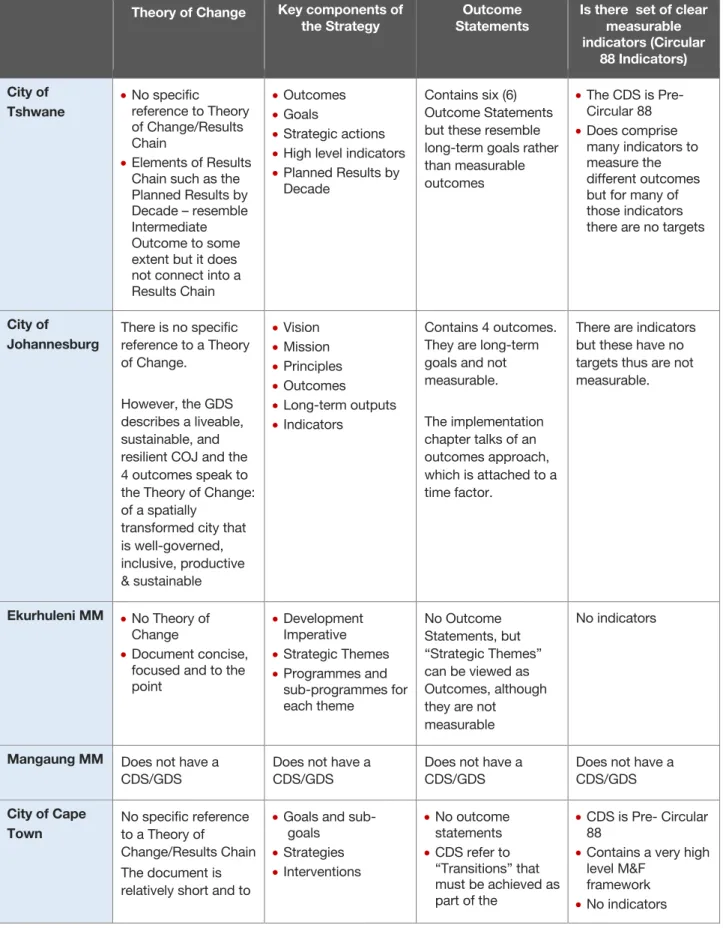
Review of Municipal Spatial Development Frameworks
Buffalo City Refer only to SPLUMA, nothing stated about utility. IUDF not mentioned - IUDF has not yet been published. Yes, included in the MSDF (not by name), but UNS geographic elements are included in the MSDF. However, the SDF refers, among other things, to land value capture tools that seek to diversify funding sources for spatial.
Specific projects are not described, except for further strategies that must be developed, at least in the short term, to enable the ROR. Not a list of priority projects in MSDF Some reference to priorities .. throughout spatial strategies, e.g. Prioritized In-situ Upgrading Projects/Priority Housing. Yes, specific detailed projects highlighted as part of activating the urban inner core: key imperatives for implementation.
MM Financial planning. is considered in the context of human settlement planning and the upgrading of informal settlements. City of Tshwane Reference to the Tshwane Strategic Investment Attraction, Facilitation and Aftercare Plan (2011 and 2016) but no evidence of how it directly impacts spatial development/spatial transformation proposals. No alignment with CDS (due to document dates). Compliance with the GDS is shown only at the end of the document in the implementation plan (almost as an afterthought) - without a logical flow.
Mangaung MM No clear evidence from MSDF No clear evidence from MSDF City of Cape Town No reference to CDS, only IDPs No specific evidence in MSDF Nelson Mandela. This is also evident from the defined strategic priorities and the process of coordinating the budget in the SDF.
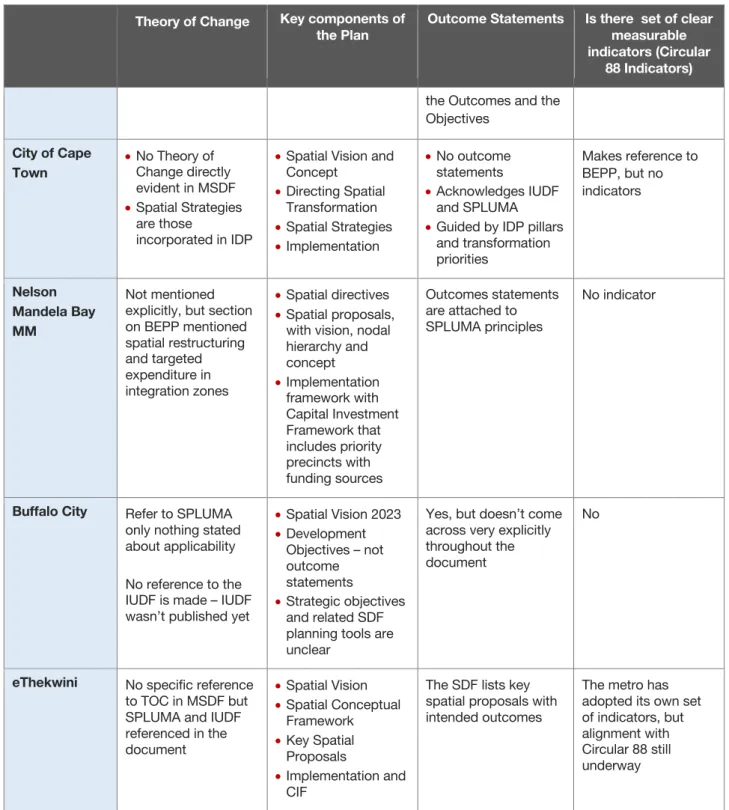
Summary of Lessons Learnt from Metropolitan Long-Term Plans and Strategies
In some of the strategies/plans it refers to the need for a financial strategy or the existence of another financial strategy. Can that system be accessed by municipal sector departments to be used as a tool for long-term sector strategies. There is no evidence of a spatial budget in any of the strategies or plans, except in the MSDF eThekwini which shows a spatial analysis of the budget that was MSCOA.
Has the city succeeded in getting IG stakeholders to disclose their programs and associated budgets? The plans/strategies all recognize the need for intergovernmental alignment and integration, but none illustrate (i) how this was done or (ii) how it proposes to do it in the future. Which platforms exist within municipalities to realize inter-administrative coordination, specifically aimed at the.
Does the city have a process or system/tool in place to filter programs and projects submitted for approval. Some of the plans either contain (i) a high-level priority framework or (ii) refer to the existence of a priority framework that exists in the municipality. Distinguishes the city between priority programs and projects, and do they have a greater weighting than others.
Does the city have longer-term frameworks and strategies compared to the mandate plan (IDP) or 5-year plans. Confused” directives regarding the long-term status of the SDF and the relationship between the duration of the mandate and the IDP Are there longer-term ones. Metropolitan municipalities must help define long-term sectoral strategies in their municipalities.
Summary of Existing Guidelines for City Development Strategies
Long Range Planning in South African Cities – A Practice Based Guide to City Development Strategies, 2018
Legislative and Policy Framework
Approach to Conceptualising a CDS
The CDS Process
Where are we now? Both as the manifestation as a city, but also as an urban population and as a municipal administration
How are we going to get there? What tools do cities have now to get to the future that they want?
What tools and associated capacities and structures do they require to get to the future they want?
Both as a manifestation as a city, but also as a city population and as a municipal council. The budget should take into account long-term infrastructure capital requirements, as well as an annual total budget requirement for operations that would be required to impact the vision, associated objectives and cross-cutting requirements of the CDS (SACN, 2018: 20).
How do we implement and measure if we are on track to achieve the desired future of the city?
CDS Structure
What does a Sustainable CDS Look Like?
Conclusion
Summary of Existing Guidelines for Metropolitan Spatial Development Frameworks
- Guidelines for the Development of Provincial, Regional and Municipal Spatial Development Frameworks and Precinct Plans, 2017
Guidelines for the production of provincial, regional and municipal spatial development frameworks and spatial plans, 2017 Framework spatial plans and spatial plans, 2017. The requirements and provisions for the preparation of spatial development plans are determined by the Spatial Planning and Spatial Use Regulation Act no. 16 of 2013 (SPLUMA). in all spheres of power. The SDF is a framework that seeks to guide the overall spatial distribution of current and desired land uses in the municipality in order to realize the vision, goals and objectives of the municipal integrated development plan (DRDLR, 2011:4).
To assist in the preparation of SDFs, the DRDLR published a set of guidelines intended to establish and communicate expectations of the role, resources, content and use of the SDF according to the requirements set out in the SPLUMA.
Legislative Mandate and Requirements
The guideline sets out how these requirements are to be met and which part of the MSDF Process Guidelines provides a detailed explanation of the process to meet this requirement.
MSDF Timeframes and Preparation Process Guidelines
MSDF Elements
The 2014 MSDF Guidelines were revised in 2017 to consider the need for a review of the guidelines in relation to municipal SDFs in relation to the BEPP process with which the NT has engaged in Metropolitan Municipalities. Related is the question of whether SDF guidance is required by Metros given their relatively high levels of skills and capacity and the extent to which planning guidance is covered in BEPP guidance. What revisions are required in order for the SDF Guidelines to better align the guidelines with the results-led planning and spatial targeting approaches adopted by the GN in the BEPP.
How SDF guidelines can build on BEPP approaches and learning to provide more consistent guidance and support by encouraging and directing private sector investment by businesses, communities and households. Whether the definition of “Capital Expenditure Framework” as set out in SPLUMA needs to be redefined in the Guidelines.
Summary of Recommendations
Should there be differentiated guidelines for Metros in relation to other types of municipalities?
Related is the question of whether SDF guidelines are required by Metros given their relatively high levels of skill and capacity and the extent to which planning guidance is covered in the BEPP
What revisions are required so that the SDF Guidelines better align the guidelines with the outcomes led planning and spatial targeting approaches adopted by the NT in the BEPPs?
Outcomes Led Planning
Spatial Targeting
How can the SDF Guidelines build on the BEPP approaches and learning to provide more consistent direction and support with leveraging and guiding private sector investment by companies,
Intergovernmental coordination and stakeholder mobilisation
Consolidated planning, budgeting and reporting and evaluation processes
Creating Space for innovation
Should the definition of a “Capital Expenditure Framework” as set out in SPLUMA be redefined in the Guidelines? Is an amendment to SPLUMA required?
MFMA Circular No. 88 - Municipal Circular on
Rationalisation Planning and Reporting Requirements for the 2018/19 MTREF
Rationalisation of planning and reporting requirements
Integrated Outcome Indicators
City Transformation Outcomes
Functional Performance Indicators (Outcomes and Outputs level)
Review of Guidelines for Spatial Development Frameworks
